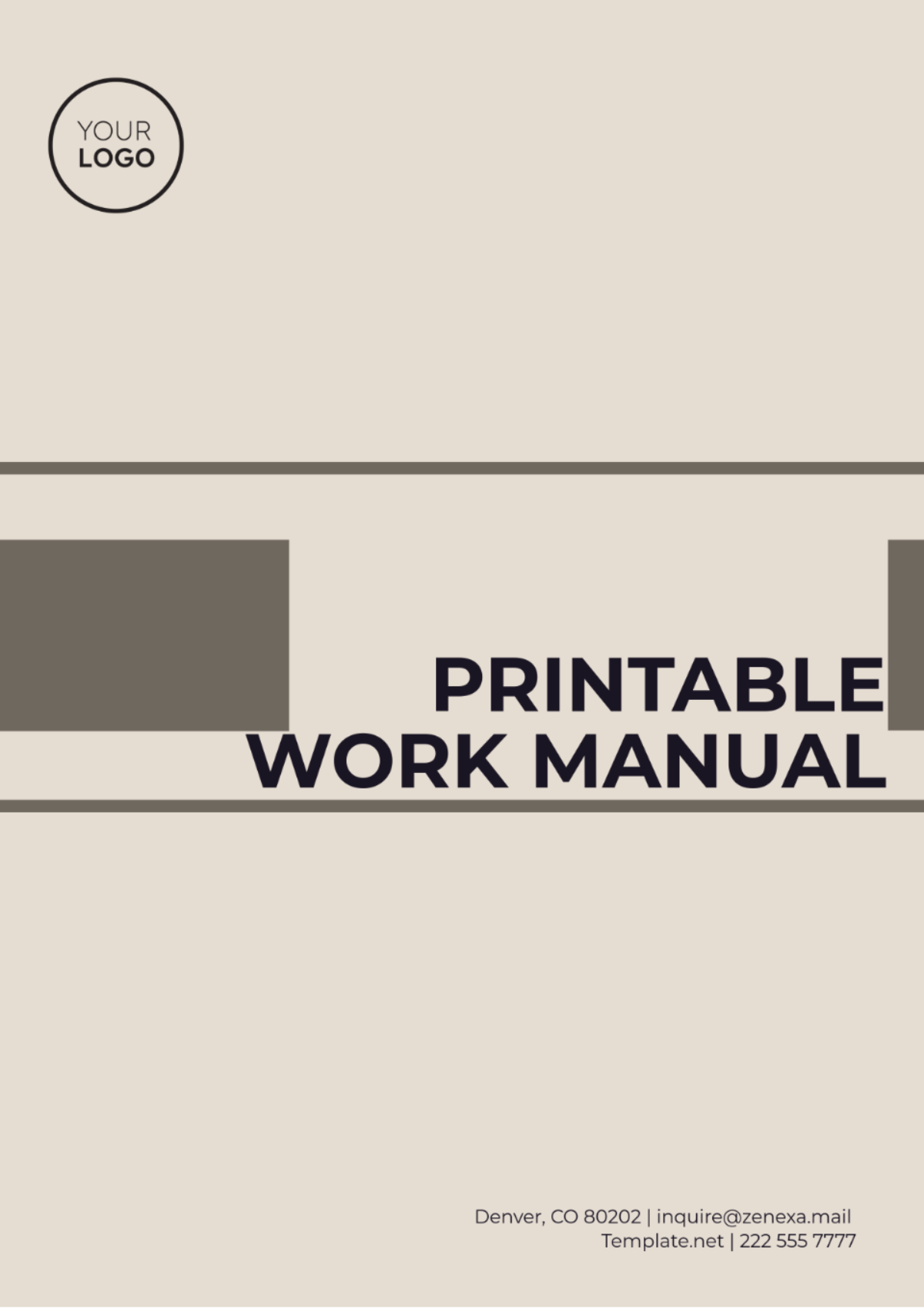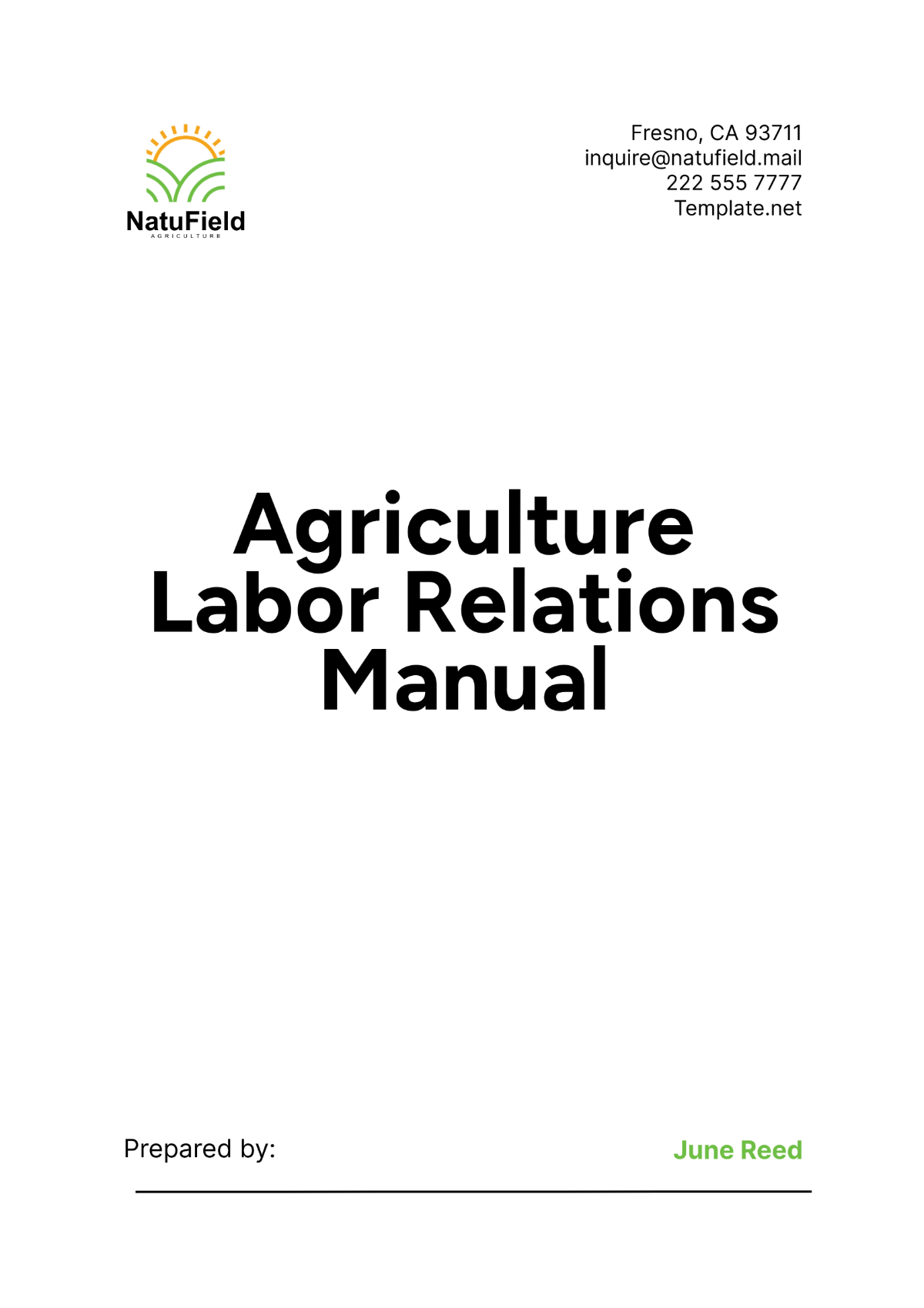Manual on Compensation, Benefits,
and Perks
Table of Contents
1. Introduction........................................................................................................2
2. Objective............................................................................................................2
3. Compensation Policy.........................................................................................3
3.1 Base Salary.......................................................................................................3
3.2 Overtime Pay...................................................................................................4
3.3 Bonuses...........................................................................................................6
4. Benefits..............................................................................................................8
4.1 Health Insurance..............................................................................................8
4.2 Retirement Plans.............................................................................................9
4.3 Paid Time Off...................................................................................................9
5. Perks..................................................................................................................9
5.1 Remote Work..................................................................................................10
5.2 Professional Development.............................................................................10
5.3 Employee Discounts......................................................................................10
6. Policy Enforcement..........................................................................................10
7. Glossary............................................................................................................10
8. Appendices......................................................................................................10
1. Introduction
Welcome to [Company Name]'s comprehensive Manual on Compensation, Benefits, and Perks. This document serves as an essential resource for Human Resources professionals, team leaders, and managers within our organization. Its primary objective is to guide you through the intricacies of understanding, implementing, and effectively communicating the various facets of employee compensation, benefits, and additional perks offered at [Company Name].
In today's competitive job market, maintaining an attractive and fair compensation and benefits structure is not just an HR requirement but a business imperative. It impacts our ability to attract, retain, and motivate the high-caliber talent that contributes to our company's success. This manual is a consolidation of [Company Name]'s policies, protocols, and best practices related to employee financial and non-financial rewards.
The information contained herein is organized into easily navigable sections that cover everything from our base salary guidelines and overtime policies to our comprehensive benefits packages, including health insurance and retirement plans. We also delve into the 'perks' that make [Company Name] a unique place to work, such as our remote work options and professional development allowances.
By adhering to the guidelines and policies set forth in this manual, you will be upholding [Company Name]'s commitment to promoting a work environment that is fair, transparent, and conducive to employee satisfaction and overall business success. Thank you for your attention to these important details, and for your role in making [Company Name] an employer of choice.
2. Objective
The primary objective of this manual is to offer clear, unambiguous guidelines and policies regarding [Company Name]'s approach to employee compensation, benefits, and perks. In an evolving business landscape, it's crucial that we maintain a consistent and transparent framework for these key aspects of employment. This manual aims to serve multiple crucial roles within the organization.
First, it aspires to ensure fairness by standardizing compensation and benefits across various departments and roles, thereby mitigating disparities and promoting an equitable work environment. Second, by clearly outlining what employees can expect in terms of compensation and benefits, we aim to bolster employee satisfaction and well-being. A satisfied employee is generally more engaged, more productive, and less likely to leave the organization, thereby reducing turnover costs.
Third, in a competitive job market, one of our ongoing challenges is to attract and retain top-tier talent. Clearly articulated and competitive compensation and benefits packages make us more appealing to prospective employees and are integral to our talent acquisition and retention strategy.
In sum, this manual serves as a cornerstone in our human capital management efforts, helping to align individual employee rewards and incentives with the broader organizational goals and values of [Company Name].
3. Compensation Policy
3.1 Base Salary
The base salary serves as the foundational element of an employee's compensation package at [Company Name]. It's the fixed amount of money that an employee can expect to earn, excluding any bonuses, benefits, or other additional compensation. The following guidelines have been established to ensure that the base salary is competitive, fair, and reflective of an employee's role, experience, and contribution to the organization.
Detailed Guidelines
Determining Base Salary for New Hires:
● Context: The initial salary offer for new employees is a crucial aspect of attracting quality talent.
● Guidelines: For new hires, the base salary will be determined based on prevailing market rates, the individual's level of experience, and relevant skills. HR should conduct periodic market research to keep abreast of industry standards.
Action Points:
● Utilize salary benchmarking tools.
● Consult salary surveys or industry reports.
● Negotiate within an approved salary range.
Annual Salary Reviews:
● Context: Regular salary reviews are vital for employee retention and job satisfaction.
● Guidelines: All employees will undergo an annual salary review during December. This review considers performance evaluations, market adjustments, and internal equity.
Action Points:
● Prepare performance metrics in advance.
● Discuss salary adjustments with department heads.
● Communicate the outcome of the review to the employees promptly.
By adhering to these guidelines, [Company Name] aims to maintain an equitable and competitive salary structure that aligns with both the market trends and the organization's financial capabilities.
Table: Base Salary Ranges by [Job Position]
Job Position | Salary Range |
Software Engineer | $70,000 - $90,000 |
Project Manager | $80,000 - $100,000 |
HR Specialist | $60,000 - $80,000 |
3.2 Overtime Pay
Overtime pay is an essential aspect of compensation for non-exempt employees who work beyond their standard working hours. This section outlines [Company Name]'s guidelines and policies related to overtime compensation, designed to comply with federal and state labor laws while ensuring that employees are fairly compensated for their additional time and effort.
Detailed Guidelines
Eligibility for Overtime:
● Context: Not all employees qualify for overtime pay; generally, only non-exempt employees are eligible.
● Guidelines: According to federal and state laws, non-exempt employees must be compensated for any work beyond the standard 40-hour workweek.
Action Points:
● Ensure proper classification of employees as exempt or non-exempt to prevent legal complications.
● Train supervisors to approve overtime in advance.
Rate of Overtime Pay:
● Context: Overtime pay rates may vary, but they are typically higher than regular hourly wages.
● Guidelines: Non-exempt employees will be compensated at a rate of 1.5 times their standard hourly wage for each hour worked beyond the standard 40 hours, in compliance with federal and state laws.
Action Points:
● Update payroll systems to automatically calculate overtime pay.
● Perform periodic audits to ensure compliance with overtime laws.
Record-Keeping:
● Context: Accurate record-keeping is essential for verifying that all non-exempt employees are paid correctly for their overtime work.
● Guidelines: Timesheets or digital time tracking systems should be utilized to accurately track hours worked.
Action Points:
● Make sure that time-tracking systems are easily accessible to employees.
● Review timesheets regularly for accuracy and compliance.
Communication:
● Context: Clear communication between management and employees is essential for effective implementation of overtime policies.
● Guidelines: Employees should be made aware of the company's policies on overtime and how to properly document their extra work hours.
Action Points:
● Issue an internal memo or newsletter detailing the overtime policy.
● Include information about overtime policies during employee orientation.
By following these guidelines, [Company Name] aims to ensure that overtime pay is administered fairly and transparently, while also staying in compliance with all applicable laws and regulations.
3.3 Bonuses
Bonuses at [Company Name] serve as an additional form of compensation designed to incentivize and reward employees for exceptional performance, specific achievements, or tenure with the company. Bonuses can take several forms, each with its criteria and purpose. Here we outline the key types of bonuses available to employees at [Company Name].
Types of Bonuses and Guidelines
Performance Bonus:
● Context: Performance bonuses are tied to an employee's individual or team contributions that significantly benefit the company, often aligned with specific performance metrics.
● Guidelines: Performance bonuses are usually awarded annually and are based on both qualitative and quantitative performance measures.
Action Points:
● Align bonus criteria with performance review metrics.
● Clearly communicate the metrics and goals that must be met to earn the bonus.
Signing Bonus:
● Context: A signing bonus is a one-time payment given to new employees as an incentive to join the company.
● Guidelines: The signing bonus amount may vary depending on the role, level of experience, and current market trends.
Action Points:
● Clearly outline the terms for the signing bonus in the employment contract.
● Ensure prompt payment after the new hire’s successful onboarding.
Referral Bonus:
● Context: Referral bonuses encourage current employees to recommend qualified candidates for open positions within the company.
● Guidelines: The bonus is awarded once the referred candidate successfully completes a probationary period.
Action Points:
● Make sure employees are aware of the referral bonus program.
● Pay the bonus promptly upon the successful completion of the referred candidate's probationary period.
By offering these different types of bonuses, [Company Name] aims to cultivate a rewarding and motivating work environment. These incentives serve to align individual and team performance with the company's broader business objectives, thus driving overall organizational success.
4. Benefits
In addition to monetary compensation, [Company Name] provides a comprehensive suite of benefits aimed at promoting employee well-being, both within and outside of the workplace. These benefits represent a significant part of our overall compensation package and are a testament to our commitment to attracting and retaining top talent. This chapter outlines the various types of benefits available to employees, including but not limited to health insurance, retirement plans, and paid time off. Each section will provide details on eligibility, specific offerings, and guidelines for utilization. By understanding and taking full advantage of these benefits, employees can better manage their health, financial security, and work-life balance.
4.1 Health Insurance
Eligibility:
● Full-time employees are eligible for health insurance coverage after 30 days of employment.
Provider:
● Our current provider is [Provider's Name].
4.2 Retirement Plans
401(k):
● [Company Name] offers a 401(k) plan, matching up to 5% of employee contributions.
4.3 Paid Time Off
Types of PTO:
● Vacation Days
● Personal Days
● Public Holidays
Table: PTO Allocation by Tenure
Years of Service | PTO Days |
0 - 1 | 10 |
2 - 5 | 15 |
6+ | 20 |
5. Perks
While benefits often cover essential life needs such as health and retirement, perks are the additional extras that make life at [Company Name] truly unique and enjoyable. These perks are designed to enhance the employee experience, foster a positive work environment, and offer avenues for personal and professional growth. In this chapter, we will delve into the variety of perks that [Company Name] proudly offers to its employees, which range from remote work opportunities to professional development allowances and exclusive employee discounts. These perks aim to not only enrich your work life but also contribute to a balanced lifestyle, continuous learning, and overall job satisfaction.
5.1 Remote Work
● Eligible employees can work remotely for up to two days per week.
5.2 Professional Development
● Employees can claim up to $1000 annually for professional development courses.
5.3 Employee Discounts
● Employees receive a 10% discount on all [Company Name] products.
6. Policy Enforcement
Compliance with the policies and guidelines outlined in this manual is imperative for maintaining a fair, equitable, and productive work environment at [Company Name]. Failure to adhere to these policies could disrupt organizational harmony and potentially place the company at legal risk. Therefore, it's essential that every employee, regardless of their role or seniority, follows the procedures and regulations outlined herein. Failure to comply may result in disciplinary action, which can range from a formal written warning to corrective training sessions, and, in severe cases, may lead to termination of employment. Such actions are taken to uphold the integrity of the company and to ensure that all employees can work in a fair and respectful environment. Employees with questions about policy interpretation or enforcement are encouraged to consult their immediate supervisor or the Human Resources department for clarification.
7. Glossary
● Exempt Employee: An employee who is exempt from overtime pay.
● Non-Exempt Employee: An employee who is eligible for overtime pay.
8. Appendices
● Appendix A: Health Insurance Plan Details
● Appendix B: 401(k) Plan Details
For questions or clarifications regarding this manual, please contact the Human Resources Department at [Company Email] or [Company Phone












